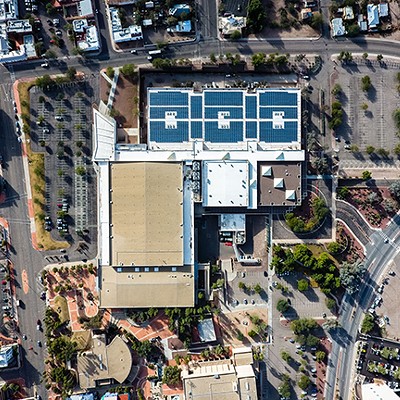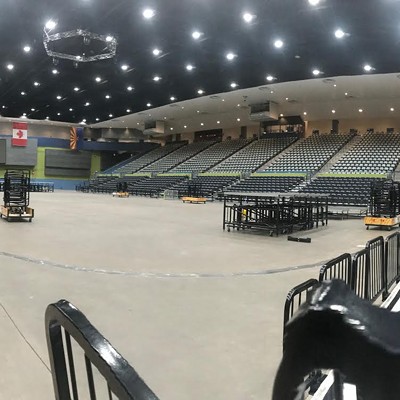(This last is a canny fake-historical creation, and, frankly, white stucco and skinny little vigas always remind me of the chi-chi strip-malls of Scottsdale, where I first encountered the look.)
But what about Tucson style? We've got some great old buildings, fabulous light and vistas, and a population roiling with artists. Yet we're too modest, too self-deprecatory to stake our claim. (This, too, is part of our identity.) Nonetheless, there is such a thing as Tucson style, and it's not about howling coyotes.
Our signature look and tone is bright, pretty and cheerfully ironic. It's profoundly influenced by Mexico, but happily embraces flavors and design elements from other sun-struck parts of the world--including the Mediterranean and South Asia. We like our schools and courthouses pink, our sunsets astounding and our bougainvillea lurid. Pale, dignified, subtle stuff doesn't hold up in the heat and glare.
For a crash course in the local sensibility, go look at South Convent Street, the Benedictine Sanctuary on Country Club Road, any of Dave Tagget's houses or the Arizona Inn. Or just pick up a copy of Kim Nelson's and Cynthia Miller's Southwest Kitchen Garden. From Nelson's fluent, helpful text to Miller's every last glowing portrait of nasturtiums and pottery and cilantro sprigs, it's a 100-page exemplar of Tucson style at its savory best.
For all its gift-book panache, though, Southwest Kitchen Garden is eminently practical. You want to know how to grow the tomatoes, greens and cukes you dream of in that caliche- and clay-ridden back yard? Here's exactly how.
Nelson, originally from a gardening family in Southern California, is a master gardener who was transplanted to the northeast side 10 years ago. She writes the "Southwest Checklist and Garden Guide" for Sunset magazine, and is the author of the exhaustive, month-by-month A Desert Gardener's Companion (Rio Nuevo, 2001)--also highly recommended. The idea for a smaller book focusing on kitchen gardens came from her years as a volunteer at the Extension Service.
"So many people I talked to there simply would not pour precious water on anything that wasn't going to produce for them," Nelson says. "You can eat what you grow in a kitchen garden, and it's as beautiful as any garden you can make." In the preface, she strongly recommends locating your garden where you can see and enjoy it.
The heart of the book is Nelson's friendly, authoritative advice about the herbs, vegetables and edible flowers that grow enthusiastically here, with a page devoted to each. The information's fresh--did you know corn evolved from wild grasses or that dill is native to southern Russia?--and Nelson's writing is so vivid you can almost smell the tomato leaves. Who but a constant gardener would think to describe our friend the sunflower as "this hairy plant" or recommend planting it on the west side of a sun-blasted plot to shade the melons and squash?
At the end, Nelson adds a couple dozen simple recipes for things like gazpacho, salsa fresca, calabacitas and basil-tomato-and-mozzarella salad--dishes that, when made with dead-ripe, homegrown produce, are as good as any food in the world. Continuing the generous, evocative pattern that makes the gardening section so charming, Nelson introduces each recipe with a memory, or credit to another cook, or a detail about who in her family likes it.
Whether you would want to risk cooking from this beautiful book, though, is another question. The off-hand air of Tucson artist Cynthia Miller's Matisse-bright illustrations belies her immense gift and love of the subject: Every herb and flower and red bell pepper is instantly identifiable, yet they all look as fresh as if a child had painted them.
According to Nelson, Miller is an aspiring gardener with a self-described "caliche thumb."
"She says that what she can't grow, she can at least paint," Nelson says.
Whether you actually cultivate your own little patch of earth, or just want to dream and look at the pictures, this is a delightful--and very stylish, very Tucson--book.










